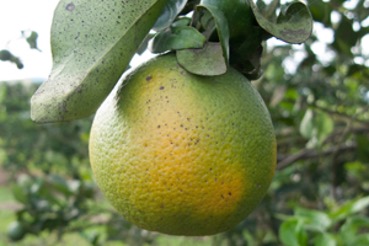Citrus greening, also known as Huanglongbing (HLB), is a plant disease affecting citrus production. Citrus greening is caused by the bacterium Candidatus Liberibacter asiaticus and spread by the Asian citrus psyllid. This disease affects plant tissue, specifically the phloem, and reduces nutrient uptake (Burrow et al. 2018).
In the United States, citrus greening was first observed in South Florida’s non-commercial citrus in August 2005. By February 2010, citrus greening had spread throughout the traditional citrus areas of the state: Central Florida, Southwest Florida, and Indian River. Elsewhere in the U.S., citrus greening was detected in Louisiana in 2008, and then detected in Georgia and South Carolina in 2009. In 2012, HLB was detected in Texas and residential areas of California (APHIS 2022).
The economic effects of citrus greening on commercial citrus production manifest in three primary ways. First, the disease increases the mortality rate of citrus trees. Second, symptoms reduce the marketable yield per tree by affecting the quantity, size, visual attributes, and flavor of the fruit (Figure 1). Third, greening increases production costs as growers implement practices such as applying additional insecticides and fertilizer to mitigate damage from greening (Dewdney, Vashisth, and Diepenbrock 2023).
Florida citrus production has significantly decreased since the introduction of greening. In the last 20 years, Florida citrus production has declined from nearly 300 million boxes in the 2003-04 season to under 20 million boxes in the 2022-23 season (Figure 2). The United States Department of Agriculture’s Animal and Plant Health Inspection Service (2022) estimates that citrus greening has reduced Florida citrus production by 75% and more than doubled production costs. Further, consumer demand for citrus products has decreased during this period, import competition has increased, and major hurricanes have markedly reduced citrus production (Blazejczyk 2020).
In the 2004-05 season, citrus-producing regions of the state were impacted by four hurricanes within a six-week span, devastating citrus production (Albrigo, et al. 2005). Citrus losses from Hurricane Irma in 2017-18 season were estimated to be $490 million (Hodges et al. 2018). More recently, citrus losses from Hurricane Ian in 2022-23 season were estimated to be $247 million (Court et al. 2023). These hurricanes significantly reduced citrus production (Figure 2).
The sharp declines in citrus production due to hurricanes combined with falling citrus yields due to citrus greening have greatly diminished the size of the Florida citrus industry since the detection of citrus greening in 2005 (APHIS 2022). Major orange juice brands that once sourced exclusively from Florida now blend their juice with imports from Mexico and Brazil (Figure 3) (Bohman 2023). Nevertheless, researchers and growers continue to seek solutions to bring back the Florida citrus industry. There has been extensive research into nutritional supplements, reflective mulch, heat treatments, insecticides, and bactericides to combat the disease. Researchers are also attempting to breed a greening resistant tree, and some citrus growers have taken the prevention route by growing their citrus under protective screens (Florida Department of Citrus 2017). However, implementing these practices requires significant financial investment, meaning a low-cost comprehensive solution to the problem of greening does not yet exist.
Figure 1: Photo of citrus fruit infected with citrus greening

Figure 2: Florida Citrus Production, Boxes (2001-23)

Disclaimer
The findings and conclusions in this publication are those of the authors and should not be construed to represent any official USDA or U.S. government determination policy.
References
Albrigo, L G, R S Buker, J K Burn, W S Castle, S Futch, C W McCoy, R P Muraro, et al. 2005. “The impact of four hurricanes in 2004 on the Florida citrus industry: Experiences and lessons learned.” Proceedings of the Florida State Horticultural Society 118: 66-74.
Animal and Plant Health Inspection Service. 2022. Citrus Greening. United States Department of Agriculture. https://www.aphis.usda.gov/aphis/ourfocus/planthealth/plant-pest-and-disease-programs/pests-and-diseases/citrus/citrus-greening.
Blazejczyk, A. 2020. Citrus Fruits Accounted for 14 Percent of Fresh Fruits Available for Americans to Eat in 2018.Amber Waves, Economic Research Service, United States Department of Agriculture. https://www.ers.usda.gov/amber-waves/2020/august/citrus-fruits-accounted-for-14-percent-of-fresh-fruits-available-for-americans-to-eat-in-2018/.
Bohman, D. 2023. Orange juice brands no longer making juice from 100% Florida-grown oranges. WPTV, Scripps Media, Inc. https://www.wptv.com/news/region-indian-river-county/vero-beach/orange-juice-brands-no-longer-making-juice-from-100-florida-grown-oranges#:~:text=Then%20in%20May%202022%2C%20Florida’s,outside%20of%20the%20Sunshine%20State.
Burrow, J D, M M Dewdney, T Vashisth, and L M Diepenbrock. 2108. Citrus Greening (Huanglongbing): A Serious Threat to the Florida Citrus Industry. https://edis.ifas.ufl.edu/publication/CH198.
Court, C D, X Qiao, B B Saha, F He, and K McDaid. 2023. Estimated Agricultural Losses Resulting from Hurricane Ian.Economic Impact Analysis Program, Food and Resource Economics Department, Institute of Food and Agricultural Sciences, University of Florida. https://fred.ifas.ufl.edu/media/fredifasufledu/economic-impact-analysis/reports/FRE-Final-Hurricane-Ian-Report.pdf.
Dewdney, M M, T Vashisth, and L M Diepenbrock. 2023. 2023–2024 Florida Citrus Production Guide: Huanglongbing (Citrus Greening). https://edis.ifas.ufl.edu/publication/CG086.
Florida Department of Citrus. 2017. “Potential Citrus Greening Solutions.” https://www.floridacitrus.org/grower/fdoc-citrus-411/potential-citrus-greening-solutions/.
Florida’s Natural. 2023. Our Family of Juices. https://floridasnatural.com/our-juices/orange-juices.
Hodges, A W, C D Court, R L Clouser, J J Vansickle, and S E Stefanou. 2018. Economic Losses of Hurricane Irma on Agriculture. Economic Impact Analysis Program, Food and Resource Economics Department, Institute of Food and Agricultural Sciences, University of Florida. https://fred.ifas.ufl.edu/destudio/t4/pdf/Economic%20Losses%20of%20Hurricane%20Irma%20on%20ag%20in%20Florida%20counties%2010-26-2018.pdf.
National Agricultural Statistics Service. 2023. Citrus Summary Reports, 2001-2023. United States Department of Agriculture. https://www.nass.usda.gov/Statistics_by_State/Florida/Publications/Citrus/index.php.


